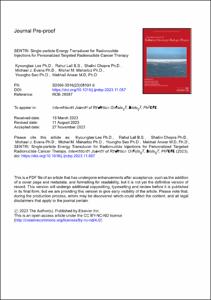Department of Electrical Engineering and Computer Science
Sensor Systems and Circuits Laboratory
1. Journal Articles
SENTRI: Single-particle Energy Transducer for Radionuclide Injections for Personalized Targeted Radionuclide Cancer Therapy
- Title
- SENTRI: Single-particle Energy Transducer for Radionuclide Injections for Personalized Targeted Radionuclide Cancer Therapy
- Author(s)
- Lee, Kyoungtae ; Lall, Rahul ; Chopra, Shalini ; Evans, Michael J. ; Maharbiz, Michel M. ; Seo, Youngho ; Anwar, Mekhail
- Issued Date
- 2024-04
- Citation
- International Journal of Radiation Oncology Biology Physics, v.118, no.5, pp.1575 - 1584
- Type
- Article
- ISSN
- 0360-3016
- Abstract
- Purpose: Targeted radionuclide therapy (TRT), whereby a tumor-targeted molecule is linked to a therapeutic beta- or alpha-emitting radioactive nuclide, is a promising treatment modality for patients with metastatic cancer, delivering radiation systemically. However, patients still progress due to suboptimal dosing, driven by the large patient-to-patient variability. Therefore, the ability to continuously monitor the real-time dose deposition in tumors and organs at risk provides an additional dimension of information during clinical trials that can enable insights into better strategies to personalize TRT. Methods and Materials: Here, we present a single beta-particle sensitive dosimeter consisting of a 0.27-mm3 monolithic silicon chiplet directly implanted into the tumor. To maximize the sensitivity and have enough detection area, minimum-size diodes (1 μm2) are arrayed in 64 × 64. Signal amplifiers, buffers, and on-chip memories are all integrated in the chip. For verification, PC3-PIP (prostate-specific membrane antigen [PSMA]+) and PC3-flu (PSMA–) cell lines are injected into the left and right flanks of the mice, respectively. The devices are inserted into each tumor and measure activities at 5 different time points (0-2 hours, 7-9 hours, 12-14 hours, 24-26 hours, and 48-50 hours) after 177Lu-PSMA-617 injections. Single-photon emission computed tomography/computed tomography scans are used to verify measured data. Results: With a wide detection range from 0.013 to 8.95 MBq/mL, the system is capable of detecting high tumor uptake as well as low doses delivered to organs at risk in real time. The measurement data are highly proportional (R2 > 0.99) to the 177Lu-PSMA-617 activity. The in vivo measurement data agree well with the single-photon emission computed tomography/computed tomography results within acceptable errors (±1.5%ID/mL). Conclusions: Given the recent advances in clinical use of TRT in prostate cancer, the proposed system is verified in a prostate cancer mouse model using 177Lu-PSMA-617. © 2023 The Author(s)
- Publisher
- Elsevier
- Related Researcher
-
-
Lee, Kyoungtae
- Research Interests Sensor IC; Battery Management IC; Cancer Radiotherapy
-
- Files in This Item:
-
 기타 데이터 / 1.49 MB / Adobe PDF
download
기타 데이터 / 1.49 MB / Adobe PDF
download



